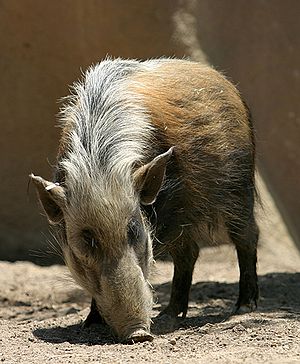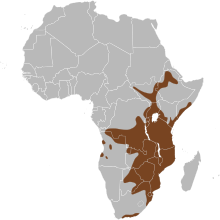Bush pig
| Bush pig | ||||||||||||
|---|---|---|---|---|---|---|---|---|---|---|---|---|

Bush pig ( Potamochoerus larvatus ) |
||||||||||||
| Systematics | ||||||||||||
|
||||||||||||
| Scientific name | ||||||||||||
| Potamochoerus larvatus | ||||||||||||
| ( F. Cuvier , 1822) |
The bush pig ( Potamochoerus larvatus ) is a species of mammal from the family of real pigs (Suidae) that is widespread in eastern and southern Africa .
features
Bush pigs are less contrasting in color than the brush-ear pigs , with which they were previously included in a species. Their fur is more shaggy, the color of the fur can vary from reddish brown to gray and almost black. The lighter colored back mane, which extends from the nape to the back, is striking. The tufts of hair on the leaf-shaped ears are present, but less pronounced than in the brush-eared pig. Both sexes have tusks. These elongated canines grow from the upper and lower jaw and grind against each other. The males also have wart-like protrusions on the nasal bone below the eyes.
Bush pigs reach a head body length of 100 to 150 centimeters, a shoulder height of 55 to 80 centimeters and a weight of 55 to 120 kilograms.
distribution and habitat
Although the warthog is better known, bush pigs are by far the most common and widespread wild pigs in Africa. Its distribution area is in eastern and southern Africa and extends from Ethiopia to South Africa . They are adapted to different habitats and occur in rain and dry forests as well as in swamp regions and thorn bush savannas. Only very dry regions such as the Sahel and the semi-desert southwest of the continent, which is covered by the Karoo and Kalahari , do not offer a suitable habitat for this species of pig. In some places these animals do not shy away from being close to humans and live in fields and near villages. A suitable habitat for bush pigs must include thickets or tall grass in which the animals can completely hide.
Wild bush pigs can also be found in Madagascar and Mayotte . Since there were naturally no pigs there, it is believed that they were brought to these islands by humans centuries ago. Other theories suggest that the pigs on driftwood have more recently reached the islands naturally.
Way of life
Bush pigs are mainly active at night and only regionally during the cool hours of the day. They sleep in dug huts and in thick bushes. They live in family groups that usually contain four to ten animals and are usually accompanied by a male. They are territorial, the area size is four to ten square kilometers. The territories are marked by glandular secretions and by scratches on tree trunks with the tusks. When two groups meet, there is loud threatening gestures, but rarely serious fights. There are also bachelor groups and loners.
Their main enemy is the leopard , after whose decimation they have become a veritable land nuisance in many parts of Africa. But lions , hyenas and wild dogs can also be dangerous to the pigs. In the event of a threat, they can run quickly and are also good swimmers. If they are cornered, they are quite defensible.
food
In search of food, they dig up roots and tubers and look for fruits and berries, but as omnivores they also eat lizards, insects, bird eggs and small vertebrates. In agricultural areas, they feed to a large extent on crops.
Reproduction
The two to six striped young animals, which are born in a self-made grass nest after a gestation period of around four months, can walk shortly after birth and follow the mother after a few days. They are weaned after two to four months and sexually mature at one and a half to three years.
Bush pigs and people
Because of their hidden way of life, it was a long time before reports of bush pig behavior in the wild were available. The bush pig was first described zoologically in 1648 by Georg Marcgrav, strangely enough in a book on the natural history of Brazil - individual animals may have reached South America with African slaves.
There is evidence that the bush hog has become consistently more abundant over the past few decades, which may be related to the decline of large predators such as leopards. Since the animals often invade plantations and destroy entire harvests, they are considered a nuisance in many places. They are also hunted for their meat.
In some areas of Africa, but especially in Madagascar, bush pigs have been tamed and kept as a source of food. A real domestication never took place, however, since the animals did not reproduce in captivity, but always came from wild stocks.
Systematics
The bush and brush-eared or river hog were previously considered a common species. Today they are listed as separate species, also because of the differences in their appearance (brush-ear pigs are more colorful) and the separate distribution area (brush-ear pigs live in western and central Africa). Together they form the genus of the bush pigs ( Potamochoerus ).
literature
- Chris Stuart, Tilde Stuart: Field Guide to the Larger Mammals of Africa . Struik, 2000, ISBN 1-86872-534-0 .
- Gus Mills, Lex Hes: Mammals of Southern Africa . Struik, 1997, ISBN 3-8290-3610-8 .
- Ronald M. Nowak: Walker's Mammals of the World . Johns Hopkins University Press, Baltimore 1999, ISBN 0-8018-5789-9 .
Web links
- Bush hog on Ultimate Ungulate (English), with photos and distribution map
- Potamochoerus larvatus in the endangered Red List species the IUCN 2006. Posted by: Pigs & peccaries Specialist Group, 1996. Retrieved on 13 11th of 2006.
